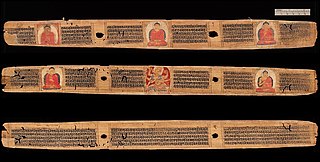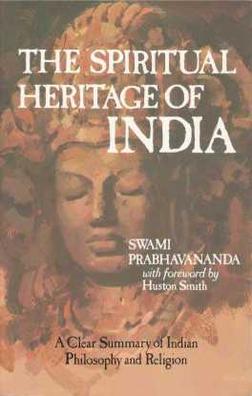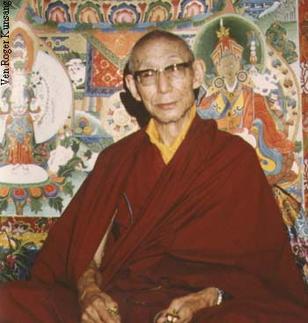
Vajrayāna, also known as Mantrayāna, Mantranāya, Guhyamantrayāna, Tantrayāna, Tantric Buddhism, and Esoteric Buddhism, is a Buddhist tradition of tantric practice that developed in Medieval India and spread to Tibet, Nepal, other Himalayan states, East Asia, and Mongolia.

The Gelug is the newest of the four major schools of Tibetan Buddhism. It was founded by Je Tsongkhapa (1357–1419), a Tibetan philosopher, tantric yogi and lama and further expanded and developed by his disciples.

The Kagyu school, also transliterated as Kagyü, or Kagyud, which translates to "Oral Lineage" or "Whispered Transmission" school, is one of the main schools of Tibetan Buddhism. The Kagyu lineages trace themselves back to the 11th century Indian Mahasiddhas Naropa, Maitripa and the yogini Niguma, via their student Marpa Lotsawa (1012–1097), who brought their teachings to Tibet. Marpa's student Milarepa was also an influential poet and teacher.

Huston Cummings Smith was a scholar of religious studies in the United States, He authored at least thirteen books on world's religions and philosophy, and his book about comparative religion, The World's Religions sold over three million copies as of 2017.

The Songs of Distant Earth is the sixteenth studio album by English musician, songwriter and producer Mike Oldfield, released on 21 November 1994 by WEA. It is a concept album based on the 1986 science fiction novel The Songs of Distant Earth by Arthur C. Clarke. The album reached No. 24 on the UK Albums Chart.

Dharanis, also known as Parittas, are Buddhist chants, mnemonic codes, incantations, or recitations, usually the mantras consisting of Sanskrit or Pali phrases. Believed to be protective and with powers to generate merit for the Buddhist devotee, they constitute a major part of historic Buddhist literature. Many of these chants are in Sanskrit and Pali, written in scripts such as Siddhaṃ as well as transliterated into Chinese, Korean, Japanese, Vietnamese, Sinhala, Thai and other regional scripts. They are similar to and reflect a continuity of the Vedic chants and mantras.

Mahākāla is a deity common to Hinduism and Buddhism.

In Vajrayana Buddhism, the Ādi-Buddha is the "First Buddha" or the "Primordial Buddha". Another common term for this figure is Dharmakāya Buddha.

Buddhist tantric literature refers to the vast and varied literature of the Vajrayāna Buddhist traditions. The earliest of these works are a genre of Indian Buddhist tantric scriptures, variously named Tantras, Sūtras and Kalpas, which were composed from the 7th century CE onwards. They are followed by later tantric commentaries, original compositions by Vajrayana authors, sādhanas, ritual manuals, collections of tantric songs (dohās) odes (stotra), or hymns, and other related works. Tantric Buddhist literature survives in various languages, including Sanskrit, Tibetan, and Chinese. Most Indian sources were composed in Sanskrit, but numerous tantric works were also composed in other languages like Tibetan and Chinese.

GyutoTantric University is one of the great monastic institutions of the Gelug Order.

Zong Rinpoche was a Gelug Lama and disciple of the third Trijang Rinpoche, junior tutor of the 14th Dalai Lama. He was famous as a sharp analyst and master of philosophical debate, as well as a Tantric practitioner. He was the Abbot of Ganden Shartse monastery.
David Sidney George Lewiston was a London-born collector of the world's traditional music. He is best known for his recordings initially released on LP on the Explorer Series of Nonesuch Records beginning in 1967.

Likir Monastery or Likir Gompa (Klud-kyil) is a Buddhist monastery in Ladakh, Northern India. It is located at 3700m elevation, approximately 52 kilometres (32 mi) west of Leh. It is picturesquely situated on a little hill in the valley, in Likir village near the Indus River about 9.5 kilometres (5.9 mi) north of the Srinigar to Leh highway. It belongs to the Gelugpa sect of Tibetan Buddhism and was established in 1065 by Lama Duwang Chosje, at the command of the fifth king of Ladakh, Lhachen Gyalpo (Lha-chen-rgyal-po). It is off the Leh-Kargil Highway, 50 km west of Leh between Alchi & Basgo, 17 km west of Basgo Monastery & 21 km northeast of Alchi Monastery.

The Spiritual Heritage of India is a book written by Swami Prabhavananda (1893–1976), founder and head of the Vedanta Society of Southern California from 1930 until his death. Originally published in 1962 by Doubleday, the book has been republished with the same title in several later editions, including hardcover, paperback, and sound recording. It has been reviewed in magazines and professional journals. A foreword by Huston Smith was first included in a 1979 edition.

The Third Trijang Rinpoche, Lobsang Yeshe Tenzin Gyatso (1901–1981) was a Gelugpa Lama and a direct disciple of Pabongkhapa Déchen Nyingpo. He succeeded Ling Rinpoche as the junior tutor of the 14th Dalai Lama when the Dalai Lama was nineteen years old. He was also a lama of many Gelug lamas who taught in the West including Zong Rinpoche, Geshe Rabten, Lama Yeshe, Kelsang Gyatso, and Lama Zopa Rinpoche. Trijang Rinpoche's oral teachings were recorded by Zimey Rinpoche in a book called the Yellow Book.

(Kyabje) Choden Rinpoche was a contemporary yogi-scholar of the Gelugpa school of Tibetan Buddhism and a reincarnation ('sprul-sku') of the Choden lineage, the historical abbots of Rabten Monastery (Tibetan: རབ་བརྟེན་དགོན་པ, Wylie: in Rong-bo district, Kham.

Chants of India is an album by Indian musician Ravi Shankar released in 1997 on Angel Records. Produced by his friend and sometime collaborator George Harrison, the album consists of Vedic and other Hindu sacred prayers set to music, marking a departure from Shankar's more familiar work in the field of Hindustani classical music. The lyrical themes of the recorded chants are peace and harmony among nature and all creatures. Sessions for the album took place in the Indian city of Madras and at Harrison's home in Henley-on-Thames, Oxfordshire, following his work on The Beatles' Anthology (1995). Anoushka Shankar, John Barham, Bikram Ghosh, Tarun Bhatacharaya and Ronu Majumdar are among the many musicians who contributed to the recording.
Jangsem Sherab Zangpo, also known as Jangsem Sherab Sangpo, (1395-1457) was a 15th-century Buddhist monk and teacher, and one of the six contemporary disciples of Je Tsongkhapa, the founder of one of the newest school of Tibetan Buddhism, the Gelug school. He is crediting with establishing the famed Thikse Monastery and the remotely located Phugtal Monastery in Ladakh, in the North Indian state of Jammu and Kashmir.
Classes of Tantra in Tibetan Buddhism refers to the categorization of Buddhist tantric scriptures in Indo-Tibetan Buddhism. Tibetan Buddhism inherited numerous tantras and forms of tantric practice from medieval Indian Buddhist Tantra. There were various ways of categorizing these tantras in India. In Tibet, the Sarma schools categorize tantric scriptures into four classes, while the Nyingma (Ancients) school use six classes of tantra.
Undertone singing is a set of singing techniques in which the vocalist makes use of vibrations of the vocal apparatus in order to produce subharmonic tones below the bass tone and extend the vocal range below the limits of the modal voice. In particular, the sound is produced via constricting the larynx in order to produce oscillations in the vocal cords and vestibular folds at certain frequencies of the vocal cords - corresponding to integer divisions of the frequency produced by the vestibular folds, such as 1:2, 1:3, and 1:4 ratios. This will produce the corresponding subharmonic to that frequency. For example, in a 1:2 ratio, each second vibration of the vocal folds, the vestibular fold will complete a single vibration cycle which will result in an subharmonic produced an octave below the bass tone produced by the vocal cords. This technique is found in certain Tibetan forms of Buddhist Chant, as practised by monks of the Gyuto Order, as well as in Mongolian throat singing, where it is often used in conjunction with other vocal techniques, such as vocal fry. The technique produces a deep, growling quality.
















